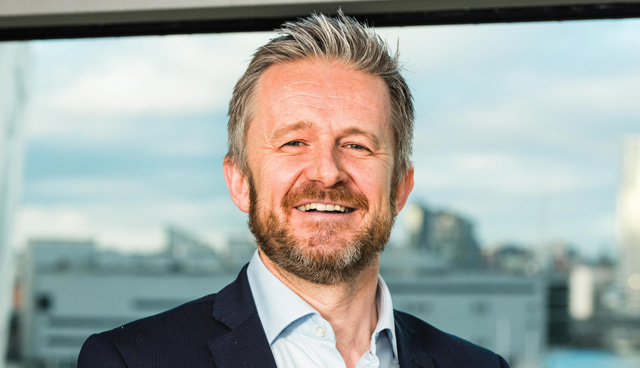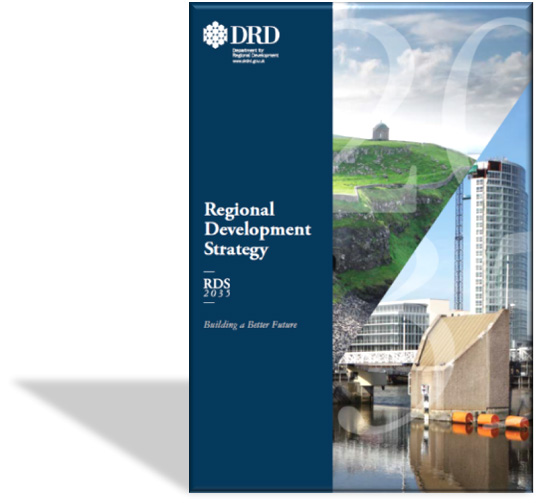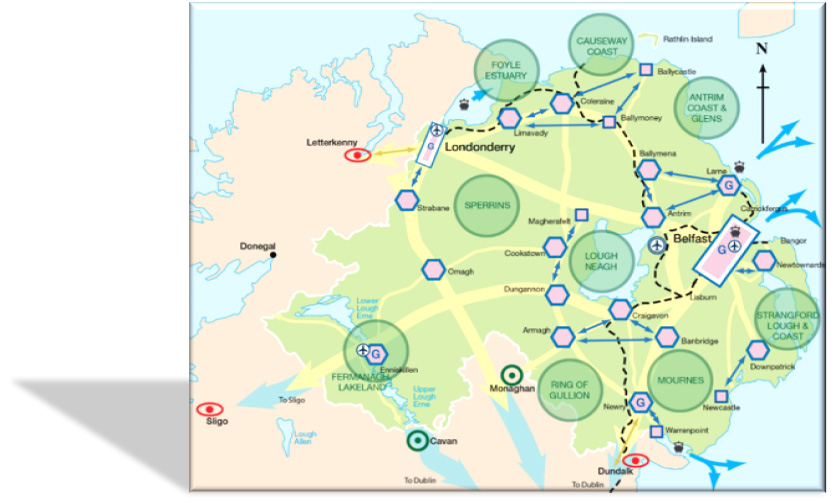Planning for sustainable growth

How we invest in our infrastructure and what infrastructure we invest in will not only determine the future prosperity of Northern Ireland but also who will benefit from it, explains Chief Planner and Director of Regional Planning for the Department for Infrastructure (DfI), Angus Kerr.
“Failure to invest in infrastructure will constrain growth at both a local and regional level”, states Kerr, as he discusses planning’s fundamental role in delivering sustainable growth across Northern Ireland.
The Chief Planner recognises the considerable reach of the DfI in affecting the everyday lives of people and describes a passion within the planning division to work together with their partners to assist in the achievement of the draft Programme for Government outcome of “improving wellbeing for all by tackling disadvantage and driving economic growth”.
“We have a clear focus on the fact that DfI is a key contributor to a number of the outcomes, from unlocking the economic potential of the region to tackling disadvantage, protecting the environment and promoting the health and wellbeing of our citizens,” he says.
“In delivering these outcomes DfI does not wish to be thought of in terms of its individual functions such as regional planning, roads and water but rather that we have a connected purpose about our role in the wider piece. This is centred around the realisation that what we do matters to people and essentially, we are a department that care about people, opportunities and places.”
The challenges to the Department’s vision of creating better places for sustainable growth extend beyond, but include, the impact of the pandemic. A three-year absence of ministerial decision-making was ended in January 2020 with the return of the Northern Ireland Executive, but any hopes of immediate progress were largely curtailed when the scale of tackling the outbreak was realised.
While the financial implications of Covid-19 are not yet fully clear, undoubtedly, economic decline will affect hopes for increased levels of infrastructure spend. The Department continues to operate in a difficult financial environment, evidenced by the fact that its 2019-2020 budget decreased by over 30 per cent when compared to the previous year.
Additionally, uncertainties around Brexit’s economic impact remain and as Kerr highlights, global and national challenges such as an ageing population, rapid technological changes, declining high streets and town centres and the response to climate change crisis remain.
Speaking at the end of 2019, Kerr said:“These are all areas in which we think planning and the wider department have a key role to play but it’s a challenging time to be involved in doing that,” explains Kerr. “However, we’re making significant progress in helping to deliver the collective vision of improving wellbeing for all, tackling disadvantage and driving sustainable economic growth.”
Land use planning
Setting out the role of the Department in regard to planning for economic sustainable growth, Kerr points to the Department’s purpose statement of: “Every day connecting people safely, supporting opportunities and creating sustainable living places.” The inclusion of creating sustainable living places, he says, embodies the importance and value that the Department put on place shaping and placemaking in relation to sustainable growth “and delivering better outcomes for people, on the ground, where it really matters”.
The Regional Development Strategy (RDS 2035) is intent on providing long-term spatial growth and development in Northern Ireland and influences the future distribution of development throughout the region, taking into account key driving forces such as population growth and movement, demographic change, transportation needs, the economy, climate change and the spatial implications of Northern Ireland’s divided society, outlines Kerr.
“Despite being in existence for quite some time it does remain relevant today and is a key part of our daily work both in planning and in interacting with councils,” he says.
“Implementation of the vision and the aims of the Strategy requires a spatial framework to enable strategic choices to be made in relation to where growth and development go. It provides for a degree of continuity with existing policy but sets a direction and priorities for better achieving sustainable development for future generations.”
Kerr stresses that the Department needs to go beyond the RDS and anticipate the long-term needs of people and the economy for the decades ahead.
“We need to start strategically directing investment to create the conditions and the capacity for growth cohesion. It is in this context that infrastructure becomes very significant. How we invest in our infrastructure and what we invest in will not only determine the future prosperity of Northern Ireland but also who will benefit from it. If we fail to invest, we will constrain growth both at a local and regional level.”
The Director of Regional Planning outlines the adoption of a wider approach to development within the Department which has led to ongoing work to create a bespoke infrastructure delivery plan for Northern Ireland.
 “Building on the key spatial elements of the current Regional Development Strategy, this strategy will be evidence-based and should transform how we address the demand for and supply of infrastructure at a regional level,” he says, highlighting that preparatory work began in advance of the return of the Executive but that such a plan will require political agreement if it is to progress to fruition.
“Building on the key spatial elements of the current Regional Development Strategy, this strategy will be evidence-based and should transform how we address the demand for and supply of infrastructure at a regional level,” he says, highlighting that preparatory work began in advance of the return of the Executive but that such a plan will require political agreement if it is to progress to fruition.
Kerr believes that the regional infrastructure delivery plan has the potential to bring a new, long-term approach to infrastructure planning for the Department and will aim to identify, at a strategic level, where there are gaps and constraints in the current infrastructure network and how to address these in the future.
“Key strategic questions for the plan to address will include things like where will people live and work in the future given the current challenges we face, how will likely economic scenarios, technological changes, climate change etcetera impact the design and delivery of infrastructure, how this will impact on communities and on the built and natural environment and, critically, how will infrastructure in Northern Ireland be funded going forward,” explains Kerr, adding that successful delivery will rely upon collaboration and co-operation across a number of government departments, councils and relevant stakeholders.
Sitting underneath the Regional Development Strategy is the Department’s Strategic Planning Policy Statement for Northern Ireland (SPPS), which sets out a policy context and as Kerr explains: “Recognises that the objective of our planning system is to secure the orderly and consistent development of land, while furthering sustainable development and improving wellbeing as enshrined in the Planning Act (Northern Ireland) 2011.”
The SPPS sets out, for the first time, five core planning principles for sustainable development. “The modern, efficient, effective planning system is essential to supporting and promoting long-term sustainable economic growth in the interests of all the people across the region,” states Kerr. “The SPPS directs that planning authorities should take a positive approach to appropriate economic development proposals and proactively support growth generating activities.
“Large scale investment proposals with job creation potential should be given particular priority. Planning authorities should also recognise and encourage proposals that could make an important contribution to sustainable economic growth when drawing up their new local development plans, as well as taking decisions on development proposals.”
However, Kerr is quick to point out that supporting sustainable economic growth through proactive planning does not mean compromising on environmental standards and quality, adding that the environment is an asset for economic growth in its own right.
“Planning authorities must therefore balance the need to support job creation and economic growth with protecting and enhancing the quality of the natural and built environment. Economic growth can also positively contribute to higher social standards in health and wellbeing of society overall.
“Good design can change lives, neighbourhoods and communities for the better and create more successful places to live, bring communities together and attract business investment. It can further sustainable development and encourage healthier living, promote accessibility, inclusivity and contribute to how safe places are and feel.”
Another important tool for delivering sustainable economic growth through planning is the Department’s urban stewardship and design guide, which provides strategic guidance on how places should develop and change going forward to make them more successful for the people who use them.
“Living Places recognises the wider economic, cultural and community benefits of achieving excellence in our urban places,” explains Kerr. “It seeks to overcome professional and administrative boundaries to ensure that buildings and spaces combined create places that are successful in social and economic terms.
“Good places are important to all of us. As individuals we are drawn to them and their ability to provide for our needs, to make us feel safe and even happy. As a society, good places are a focal point of social and economic activity and help to define our collective sense of identity. In contrast, the impacts of bad places are widespread, affecting much more than simply their visual appearance. They can hamper economic performance and deter investment as well as potential customers and visitors.
“In a national and global context, Northern Ireland will be successful as a place to invest and to visit and to come to work in, largely based on its distinctive places and the quality of those places within the region.”
The Chief Planner highlights that Northern Ireland’s towns and cities have always been shaped by their economic context and outlines that acute deprivation remains a persistent problem.
“Overcoming the physical and economic barriers of inequality must therefore also be an objective of all placemaking and regeneration initiatives,” he adds. “Vibrant town centres and high streets are critical to economic growth across the region. There is no doubt that how we use our towns and cities has changed due to a number of complex factors. We need to share a vision for how our towns and high streets function into the future, including how people can get in and out of them, enjoy them and create opportunities in them.”
“Good design can change lives, neighbourhoods and communities for the better and create more successful places to live, bring communities together and attract business investment.”
To this end, Kerr says that local development plans being progressed by Northern Ireland’s councils are fundamental to sustainable growth. All 11 councils have published and consulted on their preferred options papers with the majority having now published their draft plan strategies. “This unprecedented level of plan production presents a tremendous opportunity to shape planning across the region and to deliver sustainable growth,” he states.
Supporting opportunities
Addressing another element of DfI’s vision in the shape of supporting opportunities, Kerr says that in order for the planning system to be fully effective in facilitating economic growth, there is a need to ensure that the right investment is being channelled to infrastructure to provide the conditions needed to support such growth.
“An efficient planning system is essential to supporting opportunities and promoting sustainable economic growth. The Department also has an important governance and oversight role to ensure that the effectiveness and the integrity of the planning system is maintained and enhanced,” he states.
The Department is currently taking forward recommendations from a recent departmental review on the role of statutory consultees and the performance of the planning system, with a particular focus on major applications, an area in which it hopes to improve. To assist this in September 2019 the Department published a new planning monitoring framework, which Kerr says they intend to continue to expand to “drive continuous improvement going forward”.
Connecting people safely
urning to the final part of DfI’s vision, Kerr envisages a unique opportunity at this current time to utilise the synergies between the Department’s functions of regional planning, roads and transport to facilitate more sustainable growth by integrating land-use planning and transport, “leading to more compact urban forms, reducing the need to travel, encouraging non-car modes of travel and returning streets to people rather than an over-emphasis on cars”.
Concluding, Kerr restates his recognition that the Department and the wider planning system have a key role to play in meeting the challenges of society today and in supporting the sustainable growth of the region but outlines a firm belief that this will not be achievable in isolation.
“We must be able to build positive relationships through collaborative working between all of us in government, including our many partners in business and across all sectors to achieve the collective goals that we have for sustainable growth.
“We need to carefully consider the approaches we have taken previously in planning for sustainable development and think about how we can work differently to better plan for growth in the region moving forward.
“I think we need to challenge what have become the established norms both internationally and closer to home, such as our high levels of car dependency, our large rural population and prosperity for low density living. As well as our diminishing town centres and high streets.
“Innovation and new ideas will be required to tackle these issues and enhance positive growth for our society in a truly sustainable way. As planners, I think we’re very well placed to do that. DfI is about much more that producing hard infrastructure projects. We are about people, opportunities and places and we must maintain our focus to support sustainable growth through better planning and placemaking in order to improve health and wellbeing and the future prospects of all of our citizens.”






